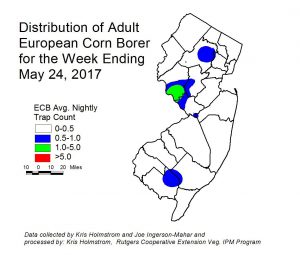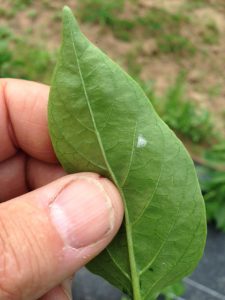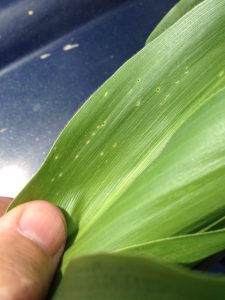Warmer weather has resulted in the first consistent European corn borer (ECB) catches. The highest catches have occurred in southern Hunterdon County (see map at  left), although there have been low, but steady catches elsewhere, including northern Cumberland and central Morris counties. As yet, feeding has been very limited, with only single-digit infestation rates on whorl corn found in Mercer County. With continued moderate temperatures, expect feeding in whorl stage corn to increase significantly over the next week. Check 5 plants each in 10 random locations for a 50 plant sample. Look for “shot-hole” injury (see photo at right), and consider treating when the number of infested plants in a 50 plant sample exceeds 12%.
left), although there have been low, but steady catches elsewhere, including northern Cumberland and central Morris counties. As yet, feeding has been very limited, with only single-digit infestation rates on whorl corn found in Mercer County. With continued moderate temperatures, expect feeding in whorl stage corn to increase significantly over the next week. Check 5 plants each in 10 random locations for a 50 plant sample. Look for “shot-hole” injury (see photo at right), and consider treating when the number of infested plants in a 50 plant sample exceeds 12%.
The highest nightly ECB catches for the previous week are as follows:
| Sergeantsville 4 | Denville 1 |
| South Branch 3 | East Vineland 1 |
| Allentown 1 | Eldora 1 |
A few corn earworm (CEW) continue to appear in blacklights throughout the state. These individuals indicate that there was limited overwintering of this pest in NJ, but are of little concern in the absence of silking sweet corn.
Cole Crops
IPM personnel continue to observe infestations of crucifer flea beetle. These beetles can build to high populations quickly, especially where wild mustard and related cruciferous weeds are common. Extreme feeding on small transplants can cause irreversible damage if not controlled promptly.
Imported cabbageworm butterflies (ICW) are active again but infestations remain fairly low due to erratic weather. Egg laying is ongoing, and infestations of this pest should increase quickly. Scout plantings weekly. Check 5 consecutive plants each in 10 random locations throughout the planting, paying particular attention to the innermost leaves where ICW often feed. Consider treating if caterpillars are found on 10% or more plants that are in the 0-9 true leaf stage. From 9-leaf to the early head stage (in broccoli, cauliflower and cabbage) infestations up to 20% may be tolerated. Once heads begin to form, a 5% threshold should be observed to protect the marketable portion of the plant. For leafy greens such as collards and kale, 10% plants infested is the threshold throughout.
Tomatoes
Aphid populations continuein high tunnel tomatoes. These pests often form colonies beneath the surface of leaves and near growing points on the plant. While the plants consist primarily of vegetative growth without fruit, aphids are largely an insignificant pest. If no broad spectrum insecticides are used on the plants, the aphids generally are decimated by predators and parasites before becoming an economic problem. Predators include syrphid (flower) fly maggots and ladybird beetles. When scouting, take note not just of the aphid populations, but of the presence of these predators. Their appearance is a sign that the aphid population could soon decline as long as predators are not disrupted. Should aphid populations increase to a degree that their droppings are accumulating on the surface of developing fruit, an insecticide that specifically targets these pests may be necessary. See the 2016-17 Commercial Vegetable Production Recommendations for materials that are labeled for aphid control in tomatoes. Avoid broad spectrum insecticide classes such as synthetic pyrethroids as much as possible. With warm temperatures now here, be watchful for the appearance of two-spotted spider mite (TSSM) infestations in the high tunnels. This pest is favored by high temperatures, and the lack of rain on tunnel-grown plants can allow TSSM populations to increase rapidly.
Peppers
 New pepper plantings are now threatened by the ECB, as moths lay eggs on the underside of pepper leaves (see photo at left). Larvae will hatch and bore into central stems of these small plants, causing the tops of the plants to die. While this is not terminal, it will prevent the production of crown fruit on affected plants. Scout 5 plants each in ten random locations. Check the underside of 2 leaves per plant. If 2 or more ECB eggmasses are found in this sample consider treating with a foliar insecticide or a soil applied insecticide such as Coragen. There are several options listed in the 2016-17 Commercial Vegetable Production Recommendations, including the OMRI approved spinosyn material, Entrust.
New pepper plantings are now threatened by the ECB, as moths lay eggs on the underside of pepper leaves (see photo at left). Larvae will hatch and bore into central stems of these small plants, causing the tops of the plants to die. While this is not terminal, it will prevent the production of crown fruit on affected plants. Scout 5 plants each in ten random locations. Check the underside of 2 leaves per plant. If 2 or more ECB eggmasses are found in this sample consider treating with a foliar insecticide or a soil applied insecticide such as Coragen. There are several options listed in the 2016-17 Commercial Vegetable Production Recommendations, including the OMRI approved spinosyn material, Entrust.
Pepper Weevil Update
Thirteen weevils were caught in a pheromone trap near a processing facility in Hammonton. The trap catch does not necessarily indicate the size of the population of the weevils in the area, only that they are present. Still, this number of weevils is troubling and farmers in the area should be monitoring for weevils in both peppers and eggplant. Information from southern Florida indicate that several fields of eggplant have been infested there.


